Low-carbon insights & trading: The business opportunity in knowing the carbon footprints of your commodities.
Ambitious climate targets, tighter regulations, and growing market pressures are prompting large agri-food companies to step up their emission reduction efforts - fueling low-carbon commodities markets. Mills and processors are in an advantageous position to capitalize on this market shift.
Healthier soils require farmers.
This World Soil Day, we share how agri-food companies can take meaningful action to improve soil health and resilience at scale, together with their suppliers and farmers. The path forward relies on farm-level insights, farmer involvement and effective tools.
Scope 3 baseline: Taking meaningful action requires farm-level data.
A Scope 3 baseline forms the foundation for supply chain reductions. To drive meaningful impact, the baseline needs to be rooted in farm-level primary data. However, when collecting farm-level information, it’s important to balance the data accuracy with speed and feasibility. Capturing farm-level details across a broad base provides a solid foundation for an actionable Scope 3 baseline.
Reducing the workload of farm-level primary data collection.
Farm-level primary data is a fundamental starting point for improved supply chain traceability, farmer engagement, regulatory compliance and efficient emissions reductions. But collecting and utilizing it has posed a significant operational challenge for most agri-food companies. How to reduce the workload of farm-level primary data collection and scale the efforts internationally?
Farmer compensation models: Market observations.
The agri-food industry is currently implementing and exploring various farmer compensation models. In this article, we examine the most common ones and highlight emerging trends and operational implications.
Agricultural emissions under CSRD: Key takeaways from the European Commission's FAQ Update.
This article unpacks what the European Commission's CSRD FAQ update reveals about the emission reporting requirements related to the agricultural value chain.
Unveiling the potential of low-carbon agricultural commodities trading.
Agri-food businesses worldwide seek ways to achieve more sustainable food production without compromising output. This article delves into one solution: low-carbon agricultural commodities trading.
Quick guide: Setting an emission reduction target for an agri-food company.
An emission reduction target is a defined goal for mitigating the company’s climate impact. Agri-food companies need one for brand and stakeholder management and for legislative compliance: large EU companies (+250 employees) are soon obliged to have a target, due to a new EU directive CSRD.
Quick read: GHG inventory - What it is and why agri-food companies need it.
GHG inventory compiles all emissions a company and its suppliers produce. 1) Food companies need a GHG inventory for brand and stakeholder management and for climate compliance. 2) The Greenhouse Gas Protocol provides international standards for creating the inventory.
How to calculate GHG emissions in the food industry.
This text will help you understand how to get started with calculating the GHG emissions your agri-food company produces. We will walk you through the 3-step process: 1) Set your reduction target. 2) Start your GHG inventory. 3) Acquire a reliable platform for gathering Scope 3 data.
Quick read: Why measuring climate impact is business-critical for food companies.
This quick-read article summarizes why it's business-critical for you as a food brand, processor, or mill to know, and show, the climate impact of your sourced commodities and consumer goods.
CSRD - What it means for the food industry.
All European food companies are now required to expand their sustainability reporting to comply with CSRD. In this text, we walk you through the basics: What CSRD is, what you are expected to report and when to take action.
Never miss a post.
Subscribe to our newsletter to access the latest deep dives and quick reads.












